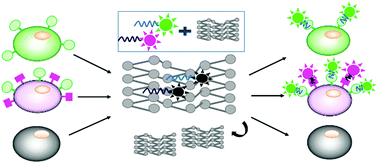Precise and label-free tumour cell recognition based on a black phosphorus nanoquenching platform†
Abstract
Breast cancer is a type of heterogeneous disease, which manifests as different molecular subtypes due to the complex nature of tumour initiation, progression, and metastasis. Accurate identification of a breast cancer subtype plays crucial roles in breast cancer management. Herein, taking advantage of the efficient quenching properties of black phosphorus nanosheets (BPNSs), in combination with the high specificity of ssDNA (or RNA) aptamer, a fluorometric duplexed assay that is capable of the simultaneous detection of two tumour markers within one run is developed. When mixed with BPNSs, the fluorescence of both FAM and Cy3 labelled aptamers was quenched. The presence of different subtypes of breast cancer cells restored the FAM and Cy3 fluorescence in distinct patterns according to their intrinsic features. The proposed assay can precisely recognise label-free breast cancer subtypes, providing an efficient method for cell type identification and guidance for subsequent breast cancer treatment. The significance of the proposed study is two-fold. First, we provide a simple method for sensitive and specific tumour cell detection; secondly, and more importantly, the proposed dual assay allows precise recognition of tumour cells and thus opens a door for rapid characterization and sorting of a wide range of tumours without using expensive instruments.



 Please wait while we load your content...
Please wait while we load your content...